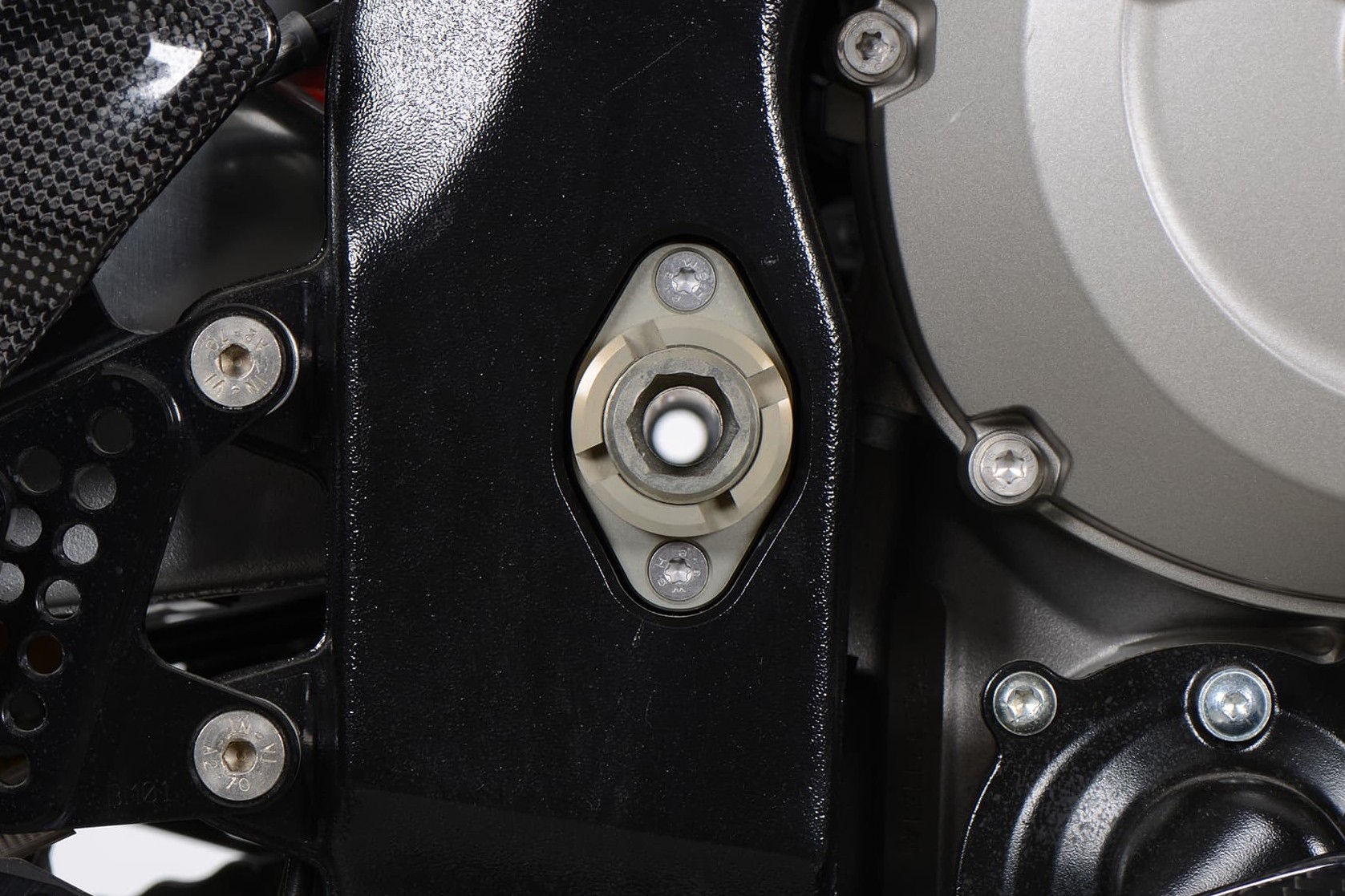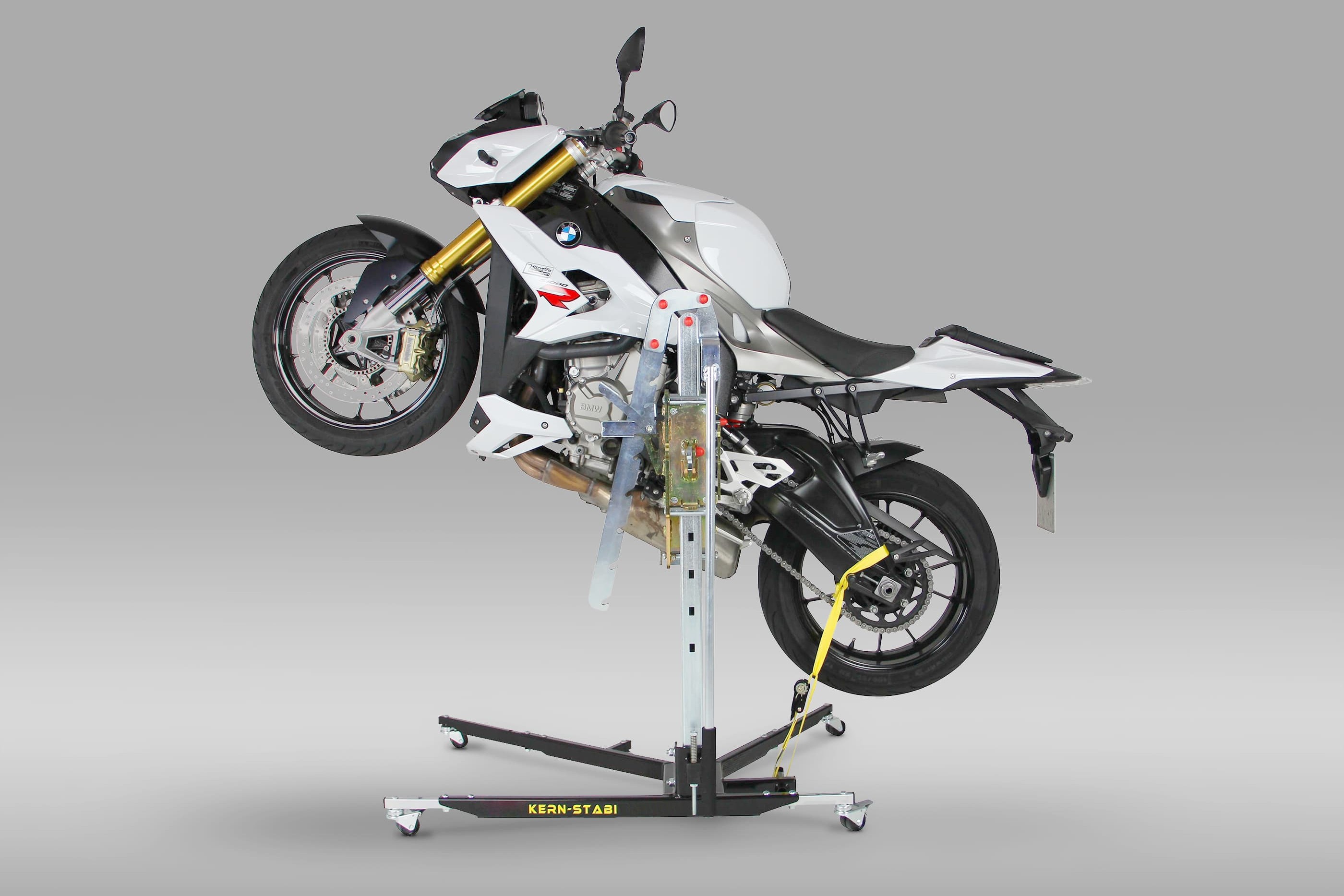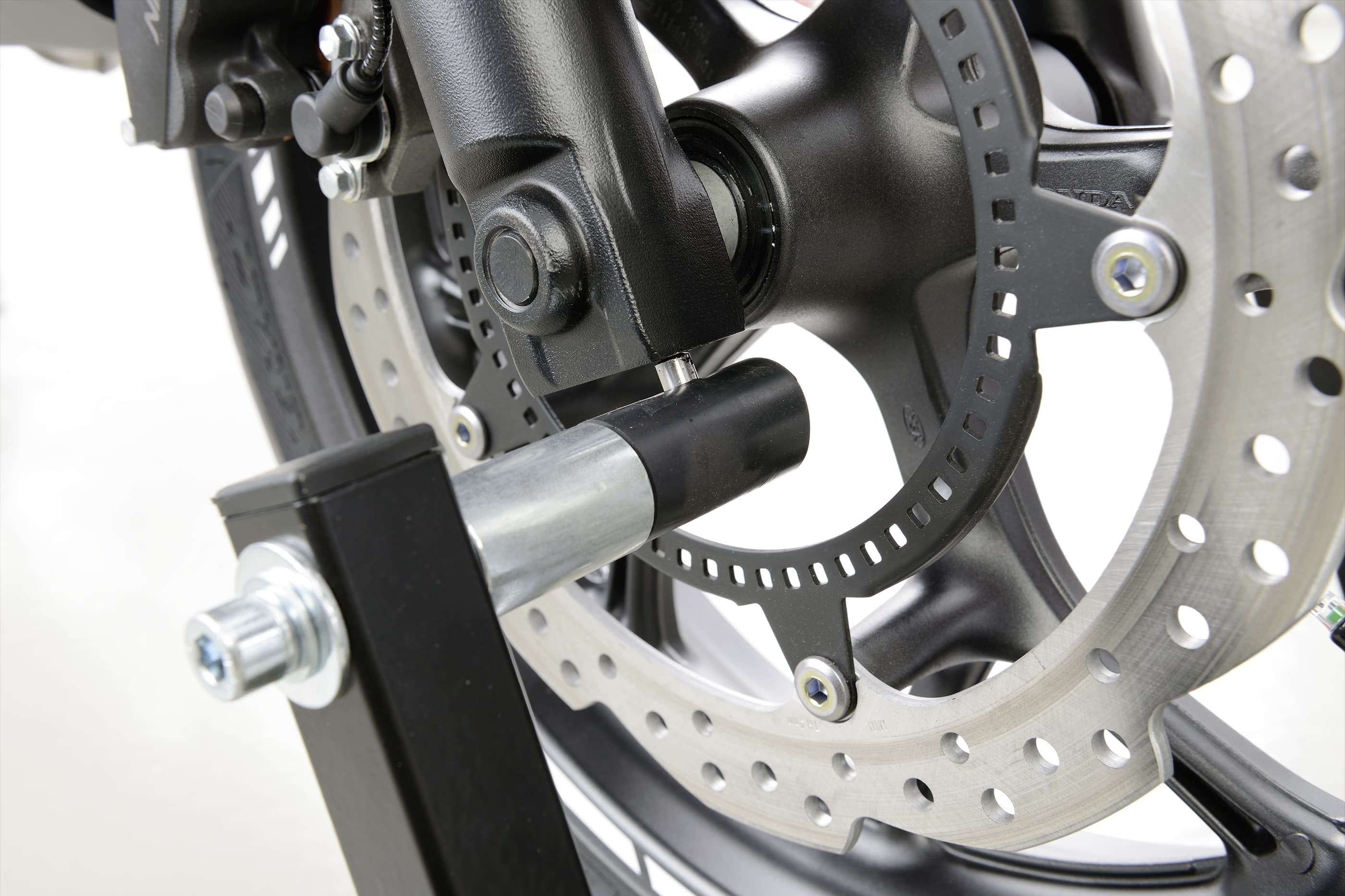Jacking up the motorcycle with paddock stands
Paddock stands are one of the best inventions since the beginning of motorcycle DIY. It's just important to have right one.

Note: The videos are in German.
- Paddock Stand Basics
- Attachment directly to the rear wheel swingarm
- Attachment to bobbins in the rear wheel swingarm
- On the single-sided swingarm
- Central stand
- Motorcycle scissor lift jack
- Motorcycle lifting table
- Chopper stand
- Stand for the swingarm axle
- Central stands
- Motocross stand
- Front head stand
- Spindle stands
- Front head stand attachment for basic rear paddock stand
- Front wheel rocker attachment for basic rear paddock stand
- Front radial adapter/pin mounts for basic rear paddock stand
- Tips for beginners
Paddock Stand Basics
Blessed are those whose motorcycle has a centre stand. Unfortunately motorcycle manufacturers omit this helpful component on many models. This could be to save weight, or because the centre stand would get in the way of other components such as the exhaust system, or simply for financial reasons. With or without stand, every motorcycle needs to be jacked up every now and again, e.g. to relieve the load on the tyres when put into winter storage and to place the motorcycle in an upright position. Or if chain maintenance, service work and repairs are necessary. Next, we'll show you how you can also get your machine off the ground even if it does not have a centre stand.
A wide range of paddock stands are available from Louis that allow the motorcycle to be raised in a stable manner. The first step is to find a suitable stand for the vehicle in terms of form and lifting capacity and also for your requirements.
The three basic types are determined by where they are attached to the motorcycle:
- On the rear wheel,
- at the centre
- or on the front wheel.
Rear stand
You can jack up the rear wheel with this type of stand. It is therefore a suitable choice for chain maintenance and removing the rear wheel, but not for removing the swingarm. This is because almost all rear paddock stands are attached the swingarm.

The simple solution for the rear wheel, can be used universally
Attachment directly to the rear wheel swingarm
Requirements: suitable for conventional box, round or oval tube swingarms not suitable for single-sided swingarms, triangular swingarms ("Softail" cruiser swingarm) or swingarms which are steeply angled or are covered by the exhaust system · license plates must be in such a way that allows the stand to be easily fitted when jacking up the motorcycle · the brake line must not be crushed, move to one side if necessary.
Advantage: Good value for money · can be used with many models.

The premium version is a worthwhile investment for motorcycle racers, for example, who frequently change their tyres
Attachment to bobbins in the rear wheel swingarm

Prevents damage to the paintwork of the swingarm.
Prerequisite: Only suitable for swingarms with lateral mounting threads for bobbins (particularly common in sport and naked bikes). To order the correct bobbins, the required thread must first be determined.
Advantage: Accurately fitting secure support · prevents damage to the paintwork of the swingarm.

One-sided but still stable: Stand for single-sided swingarms
On the single-sided swingarm

The stand adapter must fit in this hollow axle
Prerequisite: The motorcycle must be equipped with a single-sided swingarm with hollow rear axle for which a suitable stand adapter is available.
Advantage: Precise fit, secure support.

These lower frame tubes can easily carry the weight of the machine
Central stand
This type of stand is ideal for relieving the load on both wheels at the same time because it is positioned directly below the centre of gravity of the machine. This means that in addition to the front fork, the swingarm or shock absorber at the rear can also be removed. Unfortunately only a few motorcycles have been designed to allow a central stand to be safely used. Stable lower frame tubes or a flat horizontal oil sump are required for this. The exhaust manifold or fairing elements would be damaged or immediately crushed by the weight of the machine.

The motorcycle scissor lift jack is to be used with or without an adapter, depending on the motorcycle model
Motorcycle scissor lift jack
Prerequisite: Accessible lower frame tubes under which the stand can be placed in the area below the engine. If the exhaust hangs below the lower frame tubes at the sides, adapters can be used if necessary.
Advantage: Space-saving stand which, depending on the bike and whether the jacking point is slightly further forward or further back, can lift the front and also the rear wheel off the ground · swingarms can be removed · excellent solution for choppers and cruisers on which a rear paddock stand cannot be used · bike can be raised/lowered with a high degree of precision due to the threaded spindle · selectable working height.

Both stable and portable: hydraulic motorcycle lifting table
Motorcycle lifting table
Prerequisite: Accessible lower frame tubes under which the stand can be placed in the area below the engine. If the exhaust hangs below the lower frame tubes, this type of stand cannot be used · the dimensions of the stand must be suitable for the ground clearance and width of the frame.
Advantage: Large workshop stand that provides a very reliable support for the bike, also when carrying out assembly work, and can be set at a suitable working height via a foot pump · allows swingarm to be removed · once the bike is jacked up, the load on the hydraulics is relieved by a mechanical lock · the rollers allow the jacked up motorcycle to be moved around · depending on the manufacturer and model, this kind of lifting table can lift 400 or even 500 kg.

Simple and practical: this universal chopper stand performs the same function as a fitted centre stand
Chopper stand
Prerequisite: Accessible lower frame tubes under which the stand can be placed in the area below the engine. This stand cannot be used if the exhaust hangs below the lower frame tubes.
Advantage: Extremely compact stand that offers excellent value for money and can lift the bike from a point which is slightly further forwards or further back, and can also lift both the front and rear wheel off the ground · allows swingarms to be removed.

Perfect for shock absorber replacement
Stand for the swingarm axle

Hollow swingarms are ideal jacking points for this stand – suitable adapter required
Prerequisite: Hollow swingarm axle on frame for which a suitable adapter is available.
Advantage: Ideal stand for sport bikes · complete stability · protects painted components · provides ideal access to rear wheel · shock absorber can be removed.

A DIY mechanic's dream come true: the professional solution for virtually all lifting jobs
Central stands
Prerequisite: Hollow swingarm axle on frame for which a suitable adapter is available.
Advantage: Professional stand for working on sport and naked bikes · complete stability · bike can be tilted forwards or backwards to achieve the ideal working height at all times · very fast and safe jacking up procedure · protects painted components from damage · rear wheel perfectly accessible · allows fork to be completely removed · can be manoeuvred.

Jacked up in seconds: Place under motorcycle, lever it up, done.
Motocross stand
Prerequisite: The stand is suitable for light off-road motorcycles or supermotos with lower frame tubes or stable engine guard plates.
Advantage: Ideal companion for quick replacement of tyres or shock absorber elements: light, portable, robust for the workshop and the paddock · straightforward handling: Place the stand centrally under the motorcycle, jack up with the foot lever and insert the retaining pin to lock into place.

Perfect for working on the front wheel and fork: Stand attachment on handlebar tube.
Front head stand
Two suitable jacking points are available for jacking up the front wheel: the handlebar tube and fork feet.

Sufficient for removing front wheel: Stand attachment on fork feet. The latter is all you need if you want to remove the front wheel or work on the braking system. However, if you want to remove the fork, you will definitely need to use the attachment on the handlebar tube underneath the triple tree.
Important: All front head stands should always only be fitted once the rear of the bike has already been fixed by a stand!

The spindle thread is best operated with a ratchet and size 13 socket
Spindle stands
Requirements: Hollow handlebar tube (steering head) which can be accessed from below or vehicle-specific adapter. Suitable adapter for handlebar tube must be ordered separately.
Advantages: Very firm and stable, but should always be used in combination with a rear paddock stand · front wheel and fork legs can be removed · also suitable for many vehicles with long fairing nose · controlled lifting due to threaded spindle which helps avoid damage to the fairing · selectable working height · large clearance in front of the front wheel is not required to fit the stand.

The front wheel and fork are freely accessible with this stand combination
Front head stand attachment for basic rear paddock stand
Requirements: Hollow handlebar tube (steering head) which can be accessed from below. Suitable adapter for the handlebar tube must also be ordered separately · also suitable for many vehicles with long fairing nose · some clearance in front of the front wheel is required to fit the stand · this front head stand must also always be used together with a rear paddock stand.
Advantages: Reasonably priced stand which can be used as supplement to basic rear paddock stand · front wheel and fork legs can be removed.

This universal adapter can be fitted to many different fork feet
Front wheel rocker attachment for basic rear paddock stand
Requirements: Can be fitted at the fork feet of almost any front fork. Does not allow the fork legs to be removed.
Advantages: Reasonably priced stand which can be used as supplement to basic rear paddock stand · straightforward jacking up of front for wheel removal or for winter storage.

Front head stand with pin mount
Front radial adapter/pin mounts for basic rear paddock stand
Requirements: Only suitable for front wheel forks with oil discharge bores at the bottom or with a radial brake caliper with stable long support · does not allow removal of fork legs.
Advantages: Reasonably priced stand which can be used as supplement to basic rear paddock stand · straightforward jacking up of front for wheel removal or for winter storage.

Front wheel chocks make it much easier to work with rear paddock stands
Tips for beginners
Using paddock stands requires a certain amount of skill. To make sure the lifting operation is successful, a little extra help can heave the motorcycle off the sidestand and into the vertical position to allow the stand to be fitted more easily and ensure that it does not slip. If you can't find a helping hand, a mobile front wheel stand is a tried-and-tested alternative. Simply push in – done. You then have both hands free for the rear paddock stand.
Important: Please make sure that the sub-surface is firm, level and fairly smooth. Otherwise the motorcycle will not be stable. Be careful when fitting the stand. After all, a scratch is the last thing you want on your beautiful bike.
The Louis Technical Centre
If you have a technical question about your motorbike, please contact our Technical Centre, where they have endless experience, reference books and contacts.
Please note!
These tips for DIY mechanics contain general recommendations that may not apply to all vehicles or all individual components. As local conditions may vary considerably, we are unable to guarantee the correctness of information in these tips for DIY mechanics.
Thank you for your understanding.




